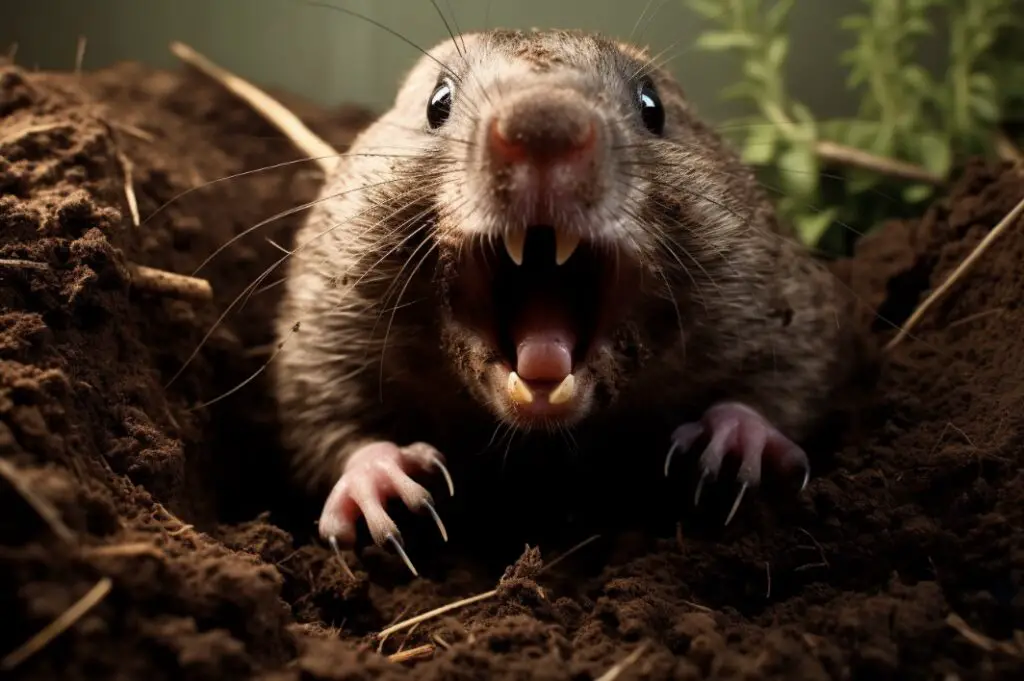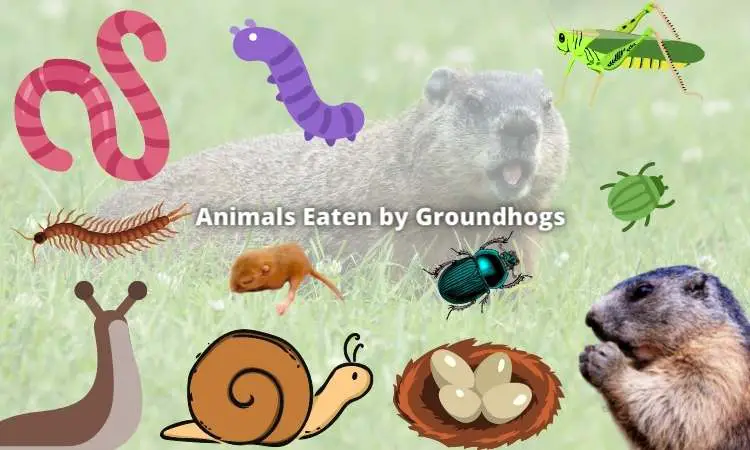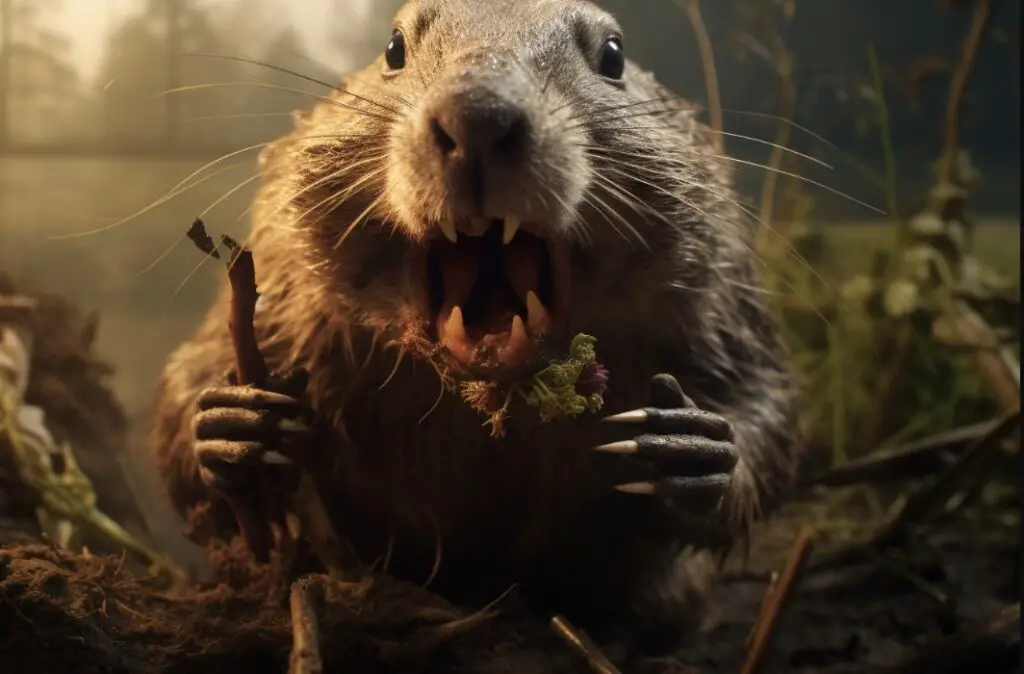When you talk of a groundhog most people probably think that they only eat plant-based food like tomatoes, squash, grass, and flowers.
But they do also eat animals, just not as much as greens!
Groundhogs will eat other animals but mainly in the form of smaller insects as a source of animal protein, but they have also been observed to eat eggs and smaller rodents and bird nestlings. However, they are not considered dangerous to humans or pets.
It is important to remember that groundhogs don’t actively hunt as they are mainly (though not entirely) herbivores, but mainly seek out the animals that appear in their foraging for other foods or when digging.
They behave similarly to gophers and prairie dogs that are fairly close relatives to the groundhogs. These rodents also don’t eat a major amount of animals, and it seems like the relative amount diminishes with size. So the gopher is probably the least meat hungry of the three.
Contents
What animals do groundhogs eat?
Groundhogs are primarily herbivores, which means that the bulk of their diet consists of plant material.

They feed on a variety of vegetation, including grasses, fruits, and vegetables, and they are particularly fond of greens like clover and dandelion.
However, they are not strict herbivores, and their diet can occasionally include small amounts of animal protein.
- Insects: Groundhogs will sometimes eat insects, and beetles are among those they might consume. Beetles can provide a good source of protein and other essential nutrients.
- Worms: Earthworms are another potential source of animal protein for groundhogs. These invertebrates can be found in the soil, which groundhogs dig through when creating their burrows. Earthworms are easy prey and a nutritious snack for groundhogs.
- Snails and slugs: These slow-moving mollusks might also be consumed by groundhogs on occasion. Like worms, they offer a protein boost.
- Small animals: It’s less common, but there have been reports of groundhogs eating small vertebrates, like young birds or rodents. However, this behavior is not typical and occurs infrequently.
- Other insects and invertebrates: Apart from beetles and worms, groundhogs might eat other small invertebrates when the opportunity arises. These can include grasshoppers, caterpillars, and other insects.
It’s worth noting that while groundhogs may consume animal protein on occasion, it doesn’t make up a significant portion of their diet.
Their primary food sources remain plants, particularly during the warm months when vegetation is abundant. Animal protein acts as a supplement, likely consumed opportunistically rather than out of preference.
What Insects do Groundhogs Eat?
They mostly eat insects that they find in the ground when they are digging or under bark from older trees. Insects are most important for the groundhog’s diet in the spring and early winter when plant food is scarce.
They eat mostly slower insects, such as slugs, snails, beetles, and worms, as their sight is bad and they are not fast enough to catch, for example, flies or dragonflies.

Do Groundhogs Eat Mice and Rats?
Groundhogs are not known to eat adult mice or rats, but they may eat younger mice or weaker ones that cannot run away if the groundhog is given the chance.
That is, on rare occasions, groundhogs have been known to eat baby mice or rats. While it is an uncommon behavior, there are a few circumstances under which this might occur:
- Opportunistic Predation: If a groundhog comes across a nest of young mice or rats, especially if the nest is unprotected or the mother is absent, the groundhog might take advantage of the situation and consume the young rodents. This is an example of opportunistic behavior, where the groundhog takes advantage of an easy protein source.
- Nutritional Needs: In times when other food sources are scarce, such as during droughts or other environmental changes, a groundhog might be more inclined to diversify its diet to ensure it receives enough nutrients. Under such conditions, they might be more likely to consume small animals, like young mice or rats, to meet their nutritional requirements.
- Territorial Behavior: Groundhogs are known to be territorial creatures. If a nest of mice or rats is too close to a groundhog’s burrow or in a location the groundhog deems as its territory, it might attack or consume the young rodents as a way to eliminate potential competition or threats.
- Curiosity or Exploration: Groundhogs are curious animals, and young or inexperienced individuals might explore different food sources. If they stumble upon young mice or rats, they might try consuming them out of curiosity or to test them as a potential food source.
While these instances of groundhogs eating young mice or rats are rare, they highlight the adaptable and sometimes unpredictable nature of animal behavior.
They rarely eat other rodents, as this is an evolutionary instinct to prevent diseases from infecting them as many diseases are shared within the rodent family. They much prefer insects when eating “meat” in their diet.
It’s essential to remember that while groundhogs might occasionally consume small vertebrates, this is not a regular part of their diet.
Would Groundhogs Kill and Eat Chickens?
Groundhogs are not known to kill or eat chickens. They may try to kill baby chicks in chicken coops if they are given the opportunity but most groundhogs will not go near a full-grown chicken.
However, they may be hazardous to chicken eggs. If they come across an egg and it is cracked, they might try to eat it. A groundhog can pretty much eat any type of animal food that we humans will, so if you have a chicken coop just be sure to get all of your eggs before the groundhog gets there.
Do Groundhogs Attack Pets Like Dogs and Cats?
Groundhogs are not aggressive to pets unless you have a close, prolonged encounter with them. However, compared to gophers, they are bigger and have a higher chance of offending pets.
They are usually more scared of the pet than the pet is of them.
They may growl at dogs but this is not meant as an attack. Groundhogs are also very good climbers and they can actually climb trees if necessary. They also often have a hole that they have dug nearby to hide in.
This makes it difficult for dogs or cats to catch them.
Groundhogs often encounter cats and dogs when they are out foraging for food in people’s backyards. They will usually flee and hide if they come face to face with a large, four-legged predator.
On the contrary dogs and cats are the ones that can attack groundhogs, so be careful when letting them loose in your yard!
However, they are usually not in danger from the pets unless they are cornered.
Will Groundhogs Eat Other Small Animals?
The only small animals that are known to be regularly eaten by groundhogs are insects such as grasshoppers, worms, and beetles.
When they come across small insects such as grasshoppers they will usually try to catch them and eat them right away.
Groundhogs will usually encounter insects when digging their underground caves. The eggs of ground-dwelling insects are often located very close to the surface of the ground, so a groundhog would have a much easier time catching it than beetles or grasshoppers, and they are nutritious too.
To keep groundhogs out of your home compound or chicken coop, simply put up a fence or barrier that is at least 2 feet tall.
They are pretty good climbers but they cannot climb over something this size. If groundhogs are already living on your property be sure to clean up any fallen fruit around the area.
See my lists of ways to keep groundhogs out of your yard in my previous post here or at the end of this post.
Are Groundhogs Aggressive to Humans?
Groundhogs are not normally aggressive to humans. They will make loud noises, sometimes hiss at you, and maybe even try to nip at us if they feel threatened or cornered. But their small teeth usually cannot make a puncture wound that is very deep.

When they are with their children it is important to keep your distance. They can feel territorial and become defensive when their young are nearby.
When they feel that something dangerous is near, they stand on their hind legs and try to get a good look at the potential threat. Their only real weapon is their mouth, which they use for digging burrows, taking food apart, and warning other animals away.
Groundhogs are not the fierce creatures that we see in stories and movies. They do not attack people unless they feel threatened or if they think you will harm their children. But there is one other type of groundhog that can be very dangerous to humans.
If you live near wooded areas, chances are that you have seen the groundhog at least once in your life. They are usually around during the spring or fall months because that is when they search for food to store up for winter.
How To Keep Groundhogs Out Of Your Yard!
There are several things that can be done to prevent groundhogs from digging and eating stuff in your backyard. I will list some of the strategies below.
Also, see my recent post if you want a full list of my favorite methods to keep groundhogs and gophers away!
1. Using ultrasonic sound
Gophers, like other pest mammals that may invade your garden, tend to have very good hearing. This means that loud or consistent noises will scare them away or at least shorten their visits.
Check out my full buying guide for these ingenious ultrasonic repeller devices here!
One of my favorite technologies to keep pests away from my backyard is these cool solar-powered ultrasonic sound emitters that you can buy right from Amazon! In my experience, they really work, and the solar panels on top save you the time and money of changing batteries all the time.
They will also work against rodents like gophers, mice, and rats!
2. Sprinkling natural repellents
Gophers may be scared off by using natural scents such as coyote urine or predator scents.
They may also cause them to leave if there is a combination of sounds being played from a radio. The sounds include the sound of barking dogs and coyotes.
You can sprinkle dog hair, cayenne pepper or strong enteric oils and other natural repellents around the garden to keep the groundhogs away.
See my complete list of humane ways to keep groundhogs away from your yard for more tips and tricks!
3. Fencing around the garden
You can also fence around your garden to keep gophers from entering the garden. It should be at least 3 feet deep and have a double row of fencing.
Groundhogs are good diggers so it has to go underground or they may find a way into the garden even with the fences in place!
4. Using live traps
You can use a live trap to capture gophers and move them to another area. Live trapping is currently the most humane way of groundhog control. Once you have removed all groundhogs from an area, it is important to ensure that they do not come back by using fencing or other barriers to block access.
You can also just buy a live trap, as the sturdy metal ones shown here:
To lure the groundhogs in, you can use one of the numerous favorite foods of groundhogs or an optimized extra attractive formula like this one to make the catch even quicker!
5. Using natural pesticides
There are pesticides or rodent toxins that can be used to kill groundhogs on your property. These may also affect other animals in the area so it is important to ensure that they are only sprayed on the targeted plants.
I do not recommend these, as I prefer more humane ways as described here. Also, anything that kills an animal will also harm humans to some degree, so go for a repellant rather than a toxin if you go the chemical route!
6. Using Scarecrows
You can use a scarecrow in your garden to keep groundhogs away. Groundhogs are afraid of novelty so time-sensitive or motion-activated scarecrows may also be effective in keeping them out of the garden.
7. Using Lights
Groundhogs are not strictly nocturnal animals but they are most active at low light so they do avoid areas with bright lights.
Motion-activated lights, sounds, and sprinklers may help prevent groundhogs from entering your yard.
Any blinking light will confuse and scare away groundhogs from your yard, especially if they are motion activated and sudden!
8. Motion-activated sprinklers
Like most animals, groundhogs hate surprises, and they will run away if suddenly sprayed with water. I like this solution because it is humane, simple, effective, and does not require much time to set up.
The Havahart 5277 is a motion-activated sprinkler that is activated by the movement of animals up to 25 feet away and sprays them with a harmless water jet, frightening them off and keeping them at bay.
The included metal stake makes it easy to install in your garden, and the sprinkler can be rotated 180 degrees for maximum coverage.
In conclusion:
Groundhogs are actually omnivores rather than herbivores. They have a diet that consists of vegetation, eggs, and small insects. However, they are not aggressive to humans most of the time unless they feel threatened or if they think you will harm their children.
They are not known to eat chickens, but they might try to eat their eggs. They are not aggressive to pets unless you have a close, prolonged encounter with them, but they might eat their food!















